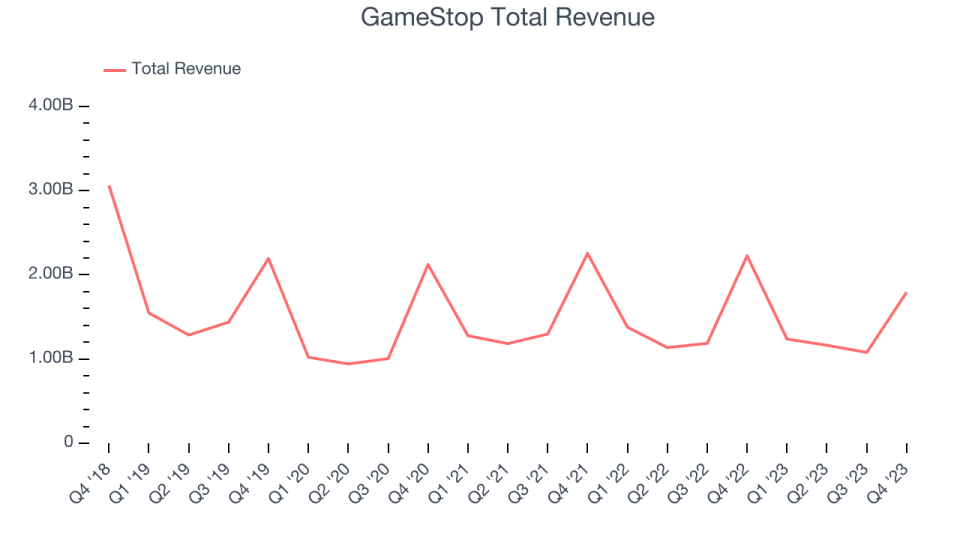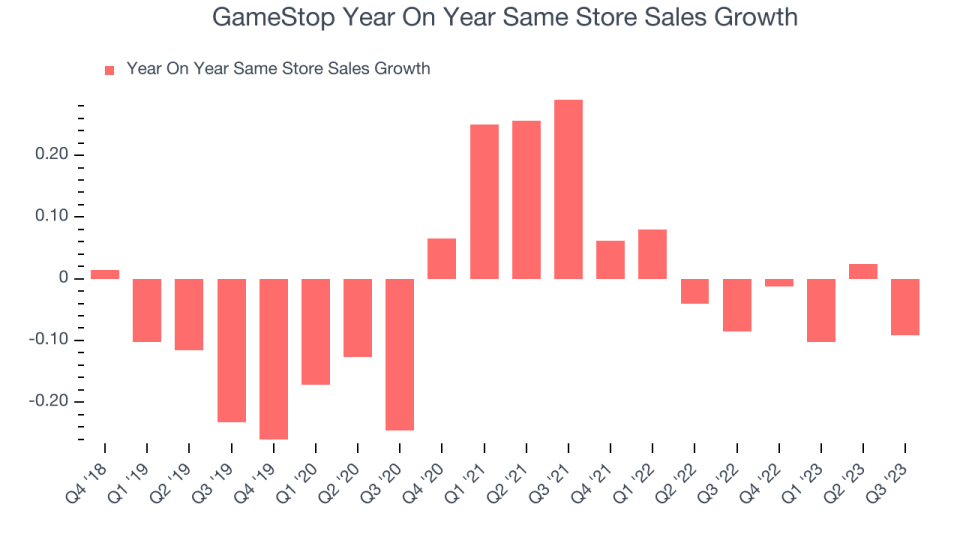GameStop (NYSE:GME) Misses Q4 Sales Targets, Stock Drops 17%

Video game retailer GameStop (NYSE:GME) missed analysts' expectations in Q4 CY2023, with revenue down 19.4% year on year to $1.79 billion. It made a non-GAAP profit of $0.22 per share, improving from its profit of $0.16 per share in the same quarter last year.
Is now the time to buy GameStop? Find out by accessing our full research report, it's free.
GameStop (GME) Q4 CY2023 Highlights:
Revenue: $1.79 billion vs analyst estimates of $2.05 billion (12.5% miss)
EPS (non-GAAP): $0.22 vs analyst expectations of $0.30 (25.4% miss)
Gross Margin (GAAP): 23.4%, up from 22.4% in the same quarter last year
Free Cash Flow was -$18.7 million, down from $326.6 million in the same quarter last year
GME did not provide any forward-looking guidance
Market Capitalization: $4.62 billion
Drawing gaming fans with demo units set up with the latest releases, GameStop (NYSE:GME) sells new and used video games, consoles, and accessories, as well as pop culture merchandise.
Electronics & Gaming Retailer
After a long day, some of us want to just watch TV, play video games, listen to music, or scroll through our phones; electronics and gaming retailers sell the technology that makes this possible, plus more. Shoppers can find everything from surround-sound speakers to gaming controllers to home appliances in their stores. Competitive prices and helpful store associates that can talk through topics like the latest technology in gaming and installation keep customers coming back. This is a category that has moved rapidly online over the last few decades, so these electronics and gaming retailers have needed to be nimble and aggressive with their e-commerce and omnichannel investments.
Sales Growth
GameStop is a mid-sized retailer, which sometimes brings disadvantages compared to larger competitors benefiting from better economies of scale. On the other hand, it has an edge over smaller competitors with fewer resources and can still flex high growth rates because it's growing off a smaller base than its larger counterparts.
As you can see below, the company's revenue has declined over the last four years, dropping 5% annually as its store count and sales at existing, established stores have both shrunk.

This quarter, GameStop missed Wall Street's estimates and reported a rather uninspiring 19.4% year-on-year revenue decline, generating $1.79 billion in revenue. Looking ahead, Wall Street expects revenue to decline 1.4% over the next 12 months.
Today’s young investors likely haven’t read the timeless lessons in Gorilla Game: Picking Winners In High Technology because it was written more than 20 years ago when Microsoft and Apple were first establishing their supremacy. But if we apply the same principles, then enterprise software stocks leveraging their own generative AI capabilities may well be the Gorillas of the future. So, in that spirit, we are excited to present our Special Free Report on a profitable, fast-growing enterprise software stock that is already riding the automation wave and looking to catch the generative AI next.
Same-Store Sales
Same-store sales growth is a key performance indicator used to measure organic growth and demand for retailers.
GameStop's demand has been shrinking over the last eight quarters, and on average, its same-store sales have declined by 3.2% year on year. The company has been reducing its store count as fewer locations sometimes lead to higher same-store sales, but that hasn't been the case here.

Key Takeaways from GameStop's Q4 Results
We struggled to find many strong positives in these results. GameStop's revenue unfortunately missed analysts' expectations, driven by significant underperformance in its software segment ($465m of revenue vs estimates of $670m). Because the company's software products have higher profit margins than its hardware products, it missed Wall Street's estimates on nearly every profitability metric. The company also didn't provide any guidance and said it would not host a conference call today to discuss the results, which raises an eyebrow. Overall, this was a bad quarter for GameStop. The company is down 17% and currently trades at $12.89 per share.
GameStop may have had a tough quarter, but does that actually create an opportunity to invest right now? When making that decision, it's important to consider its valuation, business qualities, as well as what has happened in the latest quarter. We cover that in our actionable full research report which you can read here, it's free.
